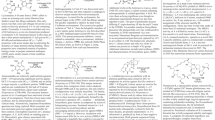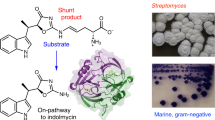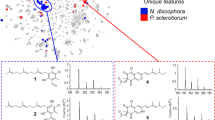Abstract
There is increasing evidence that uncultivated bacterial symbionts are the true producers of numerous bioactive compounds isolated from marine sponges. The localization and heterologous expression of biosynthetic genes could clarify this issue and provide sustainable supplies for a wide range of pharmaceuticals. However, identification of genes in the usually highly complex symbiont communities remains a challenging task. For polyketides, one of the most important groups of sponge-derived drug candidates, we have developed a general strategy that allows one to rapidly access biosynthetic gene clusters based on chemical moieties. Using this method, we targeted polyketide synthase genes from two different sponge metagenomes. We have obtained from a sponge-bacterial association a complete pathway for the rare and potent antitumor agent psymberin from Psammocinia aff. bulbosa. The data support the symbiont hypothesis and provide insights into natural product evolution in previously inaccessible bacteria.
This is a preview of subscription content, access via your institution
Access options
Subscribe to this journal
Receive 12 print issues and online access
$259.00 per year
only $21.58 per issue
Buy this article
- Purchase on Springer Link
- Instant access to full article PDF
Prices may be subject to local taxes which are calculated during checkout




Similar content being viewed by others
References
Blunt, J.W. et al. Marine natural products. Nat. Prod. Rep. 25, 35–94 (2008).
Newman, D.J. & Cragg, G.M. Marine natural products and related compounds in clinical and advanced preclinical trials. J. Nat. Prod. 67, 1216–1238 (2004).
Sipkema, D., Franssen, M.C.R., Osinga, R., Tramper, J. & Wijffels, R.H. Marine sponges as pharmacy. Mar. Biotechnol. 7, 142–162 (2005).
Schmidt, E.W. From chemical structure to environmental biosynthetic pathways: navigating marine invertebrate-bacteria associations. Trends Biotechnol. 23, 437–440 (2005).
Piel, J. Metabolites from symbiotic bacteria. Nat. Prod. Rep. 21, 519–538 (2004).
König, G.M., Kehraus, S., Seibert, S.F., Abdel-Lateff, A. & Müller, D. Natural products from marine organisms and their associated microbes. ChemBioChem 7, 229–238 (2006).
Piel, J. et al. Antitumor polyketide biosynthesis by an uncultivated bacterial symbiont of the marine sponge Theonella swinhoei. Proc. Natl. Acad. Sci. USA 101, 16222–16227 (2004).
Bewley, C.A. & Faulkner, D.J. Lithistid sponges: star performers or hosts to the stars. Angew. Chem. Int. Ed. 37, 2163–2178 (1998).
Sudek, S. et al. Identification of the putative bryostatin polyketide synthase gene cluster from “Candidatus Endobugula sertula”, the uncultivated microbial symbiont of the marine bryozoan Bugula neritina. J. Nat. Prod. 70, 67–74 (2007).
Partida-Martinez, L.P. & Hertweck, C. Pathogenic fungus harbours endosymbiotic bacteria for toxin production. Nature 437, 884–888 (2005).
Piel, J. A polyketide synthase-peptide synthetase gene cluster from an uncultured bacterial symbiont of Paederus beetles. Proc. Natl. Acad. Sci. USA 99, 14002–14007 (2002).
Taylor, M.W., Hill, R.T., Piel, J., Thacker, R.W. & Hentschel, U. Soaking it up: the complex lives of marine sponges and their microbial associates. ISME J. 1, 187–190 (2007).
Taylor, M.W., Radax, R., Steger, D. & Wagner, M. Sponge-associated microorganisms: evolution, ecology, and biotechnological potential. Microbiol. Mol. Biol. Rev. 71, 295–347 (2007).
Piel, J., Hui, D., Fusetani, N. & Matsunaga, S. Targeting polyketide synthases with iteratively acting acyltransferases from metagenomes of uncultured bacterial consortia. Environ. Microbiol. 6, 921–927 (2004).
Kim, T.K. & Fuerst, J.A. Diversity of polyketide synthase genes from bacteria associated with the marine sponge Pseudoceratina clavata: culture-dependent and culture-independent approaches. Environ. Microbiol. 8, 1460–1470 (2006).
Fieseler, L. et al. Widespread occurrence and genomic context of unusually small polyketide synthase genes in microbial consortia associated with marine sponges. Appl. Environ. Microbiol. 73, 2144–2155 (2007).
Schirmer, A. et al. Metagenomic analysis reveals diverse polyketide synthase gene clusters in microorganisms associated with the marine sponge Discodermia dissoluta. Appl. Environ. Microbiol. 71, 4840–4849 (2005).
Cichewicz, R.H., Valeriote, F.A. & Crews, P. Psymberin, a potent sponge-derived cytotoxin from Psammocinia distantly related to the pederin family. Org. Lett. 6, 1951–1954 (2004).
Pettit, G.R. et al. Antineoplastic agents. 520. Isolation and structure of irciniastatins A and B from the Indo-Pacific marine sponge Ircinia ramosa. J. Med. Chem. 47, 1149–1152 (2004).
Partida-Martinez, L.P. & Hertweck, C. A gene cluster encoding rhizoxin biosynthesis in “Burkholderia rhizoxina”, the bacterial endosymbiont of the fungus Rhizopus microsporus. ChemBioChem 8, 41–45 (2007).
Cheng, Y.Q., Tang, G.L. & Shen, B. Type I polyketide synthase requiring a discrete acyltransferase for polyketide biosynthesis. Proc. Natl. Acad. Sci. USA 100, 3149–3154 (2003).
Gu, L.C. et al. Metabolic coupling of dehydration and decarboxylation in the curacin A pathway: functional identification of a mechanistically diverse enzyme pair. J. Am. Chem. Soc. 128, 9014–9015 (2006).
Edwards, D.J. et al. Structure and biosynthesis of the jamaicamides, new mixed polyketide-peptide neurotoxins from the marine cyanobacterium Lyngbya majuscula. Chem. Biol. 11, 817–833 (2004).
Johnson, T.A. et al. Sponge-derived fijianolide polyketide class: further evaluation of their structural and cytotoxicity properties. J. Med. Chem. 50, 3795–3803 (2007).
Khosla, C., Tang, Y., Chen, A.Y., Schnarr, N.A. & Cane, D.E. Structure and mechanism of the 6-deoxyerythronolide B synthase. Annu. Rev. Biochem. 76, 195–221 (2007).
Nguyen, T. et al. Exploiting the mosaic structure of trans-acyltransferase polyketide synthases for natural product discovery and pathway dissection. Nat. Biotechnol. 26, 225–233 (2008).
Robinson, S.J. et al. Probing the bioactive constituents from chemotypes of the sponge Psammocinia aff. bulbosa. J. Nat. Prod. 70, 1002–1009 (2007).
Perry, N.B., Blunt, J.W., Munro, M.H.G. & Pannell, L.K. Mycalamide A, an antiviral compound from a New Zealand sponge of the genus Mycale. J. Am. Chem. Soc. 110, 4850–4851 (1988).
West, L.M., Northcote, P.T., Battershill, C.N. & Peloruside, A. A potent cytotoxic macrolide isolated from the New Zealand marine sponge Mycale sp. J. Org. Chem. 65, 445–449 (2000).
Northcote, P.T., Blunt, J.W. & Munro, M.H.G. Pateamine - a potent cytotoxin from the New Zealand marine sponge, Mycale sp. Tetrahedron Lett. 32, 6411–6414 (1991).
Menche, D. et al. Stereochemical determination and complex biosynthetic assembly of etnangien, a highly potent RNA polymerase inhibitor from the myxobacterium Sorangium cellulosum. J. Am. Chem. Soc. 130, 14234–14243 (2008).
Gu, L.C. et al. GNAT-like strategy for polyketide chain initiation. Science 318, 970–974 (2007).
Hrvatin, S. & Piel, J. Rapid isolation of rare clones from highly complex DNA libraries by PCR analysis of liquid gel pools. J. Microbiol. Methods 68, 434–436 (2007).
Piel, J., Höfer, I. & Hui, D. Evidence for a symbiosis island involved in horizontal acquisition of pederin biosynthetic capabilities by the bacterial symbiont of Paederus fuscipes beetles. J. Bacteriol. 186, 1280–1286 (2004).
Shen, B. Polyketide biosynthesis beyond the type I, II and III polyketide synthase paradigms. Curr. Opin. Chem. Biol. 7, 285–295 (2003).
Wenzel, S.C. & Müller, R. Myxobacterial natural product assembly lines: fascinating examples of curious biochemistry. Nat. Prod. Rep. 24, 1211–1224 (2007).
Jiang, X., Williams, N. & De Brabander, J.K. Synthesis of psymberin analogues: probing a functional correlation with the pederin/mycalamide family of natural products. Org. Lett. 9, 227–230 (2007).
Donia, M.S. et al. Natural combinatorial peptide libraries in cyanobacterial symbionts of marine ascidians. Nat. Chem. Biol. 2, 729–735 (2006).
Paul, G.K., Gunasekera, S.P., Longley, R.E. & Pomponi, S.A. Theopederins K and L. Highly potent cytotoxic metabolites from a marine sponge Discodermia species. J. Nat. Prod. 65, 59–61 (2002).
Ottesen, E.A., Hong, J.W., Quake, S.R. & Leadbetter, J.R. Microfluidic digital PCR enables multigene analysis of individual environmental bacteria. Science 314, 1464–1467 (2006).
Flatt, P. et al. Identification of the cellular site of polychlorinated peptide biosynthesis in the marine sponge Dysidea (Lamellodysidea) herbacea and symbiotic cyanobacterium Oscillatoria spongeliae by CARD-FISH analysis. Mar. Biol. 147, 761–774 (2005).
Esquenazi, E. et al. Visualizing the spatial distribution of secondary metabolites produced by marine cyanobacteria and sponges via MALDI-TOF imaging. Mol. Biosyst. 4, 562–570 (2008).
Simmons, T.L. et al. Biosynthetic origin of natural products isolated from marine microorganism-invertebrate assemblages. Proc. Natl. Acad. Sci. USA 105, 4587–4594 (2008).
Hall, T.A. BioEdit: a user-friendly biological sequence alignment editor and analysis program for Windows 95/98/NT. Nucleic Acids Symp. Ser. 41, 95–98 (1999).
Tamura, K., Dudley, J., Nei, M. & Kumar, S. MEGA4: molecular evolutionary genetics analysis (MEGA) software version 4.0. Mol. Biol. Evol. 24, 1596–1599 (2007).
Guindon, S. & Gascuel, O. A simple, fast, and accurate algorithm to estimate large phylogenies by maximum likelihood. Syst. Biol. 52, 696–704 (2003).
Piel, J., Wen, G., Platzer, M. & Hui, D. Unprecedented diversity of catalytic domains in the first four modules of the putative pederin polyketide synthase. ChemBioChem 5, 93–98 (2004).
Calderone, C.T., Kowtoniuk, W.E., Kelleher, N.L., Walsh, C.T. & Dorrestein, P.C. Convergence of isoprene and polyketide biosynthetic machinery: isoprenyl-S-carrier proteins in the pksX pathway of Bacillus subtilis. Proc. Natl. Acad. Sci. USA 103, 8977–8982 (2006).
Acknowledgements
We thank M. Page for assistance with collecting M. hentscheli of known chemotypes and S. Brady for advice on metagenomic library construction. This work was supported by a collaborative grant from the US National Science Foundation and the German Research Foundation to J.P. (PI 430/6-1) and P.C. (NSF-CHE-0617056), by grants from the German Research Foundation to J.P. (SFB 624 and SPP 1152) and by an Alexander von Humboldt Research Fellowship to S.A.v.d.S.
Author information
Authors and Affiliations
Contributions
J.P. designed the research on PKS targeting and isolation, analyzed data and wrote the manuscript; K.M.F. developed the targeting approach; K.M.F. and C.G. constructed libraries and isolated and analyzed the psy genes; N.H. isolated and analyzed the psy genes; S.A.v.d.S. conducted the PKS work on M. hentscheli; S.T. and M.P. sequenced and analyzed PCR amplicons; P.C., B.K.R. and S.J.R. collected and analyzed specimens of P. aff. bulbosa and C. mycofijiensis; V.L.W. designed research to collect and aquaculture the different chemotypes of M. hentscheli; S.A.A. performed the initial analysis of the microbe population in M. hentscheli chemotypes and selected M. hentscheli for the metagenomic work.
Corresponding author
Supplementary information
Supplementary Text and Figures
Supplementary Figures 1 and 2, Supplementary Table 1 and Supplementary Methods (PDF 280 kb)
Rights and permissions
About this article
Cite this article
Fisch, K., Gurgui, C., Heycke, N. et al. Polyketide assembly lines of uncultivated sponge symbionts from structure-based gene targeting. Nat Chem Biol 5, 494–501 (2009). https://doi.org/10.1038/nchembio.176
Received:
Accepted:
Published:
Issue Date:
DOI: https://doi.org/10.1038/nchembio.176
This article is cited by
-
Evolution of combinatorial diversity in trans-acyltransferase polyketide synthase assembly lines across bacteria
Nature Communications (2021)
-
Highlights of marine natural products having parallel scaffolds found from marine-derived bacteria, sponges, and tunicates
The Journal of Antibiotics (2020)
-
Automated structure prediction of trans-acyltransferase polyketide synthase products
Nature Chemical Biology (2019)
-
Metagenomic discovery of polybrominated diphenyl ether biosynthesis by marine sponges
Nature Chemical Biology (2017)



